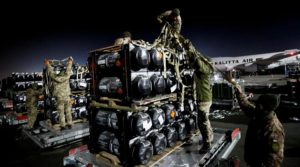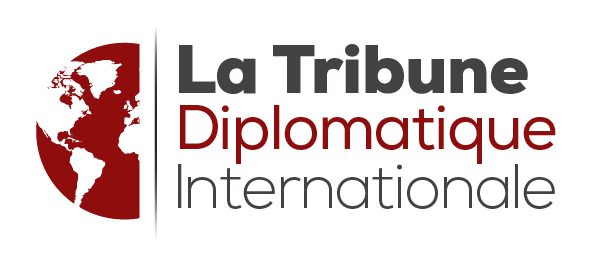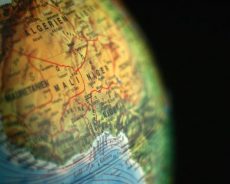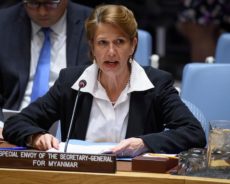![]()

The current world situation is very similar to the situation on the eve of the Second World War and, to a lesser extent, to the situation before the First World War. Indeed, in the backdrop of the Russian-Ukrainian conflict, we see occult and ideologically driven warmongering and hegemonic forces in the political, diplomatic and military worlds manoeuvring within the Empire to push for an all-out war against Russia, risking a nuclear conflict. On the other hand, other components of the Empire, from the economic ‘elites’, are also working towards a big war, to bring about a ‘reset’, a cover for a change of economic paradigm and monetary system that will make them more powerful.
After a historical review necessary to explain the constitution of the modern Empire, we will present in more detail the play of forces that lead us to a world conflict. The constitution of the modern world empire was made by successive aggregation of new forces around common paradigms.
The modern Empire: in the beginning was the British Empire
The modern Empire that claims to dominate the planet was constituted during the first half of the 20th century in four major stages, by mutations of the British Empire under the effect of the accumulation of new forces: the first stage was the indoctrination of the elites of the British Empire around a global hegemonic project. The second stage was the transformation of the British Empire into the Empire of the British-speaking peoples, and then into the Anglo-American Empire after the rise of the United States in the aftermath of the Second World War. The third stage saw its transformation into an Anglo-American-Zionist Empire, through the definitive interweaving of the Talmudic, millenarian and Zionist Jewish elite with the Anglo-Saxon oligarchy at the top of this Empire. Finally, the Empire became Anglo-American-Zionist globalized, with the incorporation of new elites from Europe and then from the rest of the world, formed mainly by aristocrats and comprador oligarchs.
Halford Mac Kinder’s world view
It is this aggregate that runs the modern Empire today, exercising control over all the powers and levers of power and sovereignty (political, military, diplomatic, administrative, police, media, cultural, economic, even ‘scientific’, over much of the planet). The first turning point of the modern Empire can be dated to the worldview developed by the Scottish academic Halford Mac Kinder in 1904, which was quickly adopted as a paradigm of thought and action by the British Empire’s elites. In his famous lecture to the Royal Geographical Society of London (1), Mac Kinder developed a worldview and a doctrine for world domination that would become the benchmark for the Empire and is still largely in place today.
Mac Kinder presented British imperial elites with Eurasia, which he described as an island-world, an immense continuum of land between Europe and Asia (including the Middle East), concentrating not only most of the world’s land surface but also most of its natural resources and population. The Mac Kinder’s ‘genius’ is to present a world globe from the China Sea to show the gigantic size of the Eurasian landmass and, by contrast, the smallness of the peninsula of continental Europe.
This paradigm still constitutes the main foundation of the Empire’s geopolitical doctrine of world domination and allows us to better understand the ‘rational’ but nonetheless ‘deadly’ hostility towards Russia, but also towards countries such as Iran or China, and even potentially India, in the future, in the event of the affirmation of its sovereigntist policy.
On this island-world, the Anglo-Saxons identified at the beginning of the 20th century a set of ‘land powers’ or ‘continental powers’ formed by history and geography: there is Germany and the Germanic world (a significant part of which is at the time within the Austro-Hungarian Empire), Turkey and the Turkish-speaking world (mainly within the Ottoman Empire, with significant extensions into the Russian Empire), the Arab-Muslim Middle East (then almost entirely integrated into the Ottoman Empire), Russia and the Slavic world (divided between the Russian Empire and the eastern part of the Austro-Hungarian Empire), Iran and the Persian world, India and the Indian subcontinent (of Hindu settlement and culture), China and the Indochinese peninsula (under Chinese cultural influence but under Anglo-French political domination at the time).
Faced with the island-world, the thalassocratic powers
Mirroring the island-world and the continental powers, Mac Kinder and his successors identified a set of so-called thalassocratic powers, i.e. maritime powers, which were the ‘natural‘ rivals of the continental powers of the island-world. These thalassocratic powers form four blocks.
The first bloc consisted of the United Kingdom (including Ireland at that time) and its Anglo-Saxon dominions, Canada in North America, Australia and New Zealand in Oceania, which were then fully part of the British Empire, before the establishment of the Commonwealth in 1931. At the time of the 1904 conference, South Africa could be added to this group, which the imperial British administration was still trying to control at all costs, even if British influence was lessened by the fierce resistance of the Boers to British rule.
The second bloc consists of the European powers on the periphery of the European continent, classified as thalassocratic: there are Portugal, Spain and France, the three former Empires militarily defeated or dominated by the United Kingdom, and Italy. These countries are associated with the thalassocratic powers, somewhat by geography, as they form a kind of large western peninsula dipped in the Atlantic and Mediterranean at the end of the gigantic Eurasian landmass on Mac Kinder’s world map, and very much for political reasons, as the British are sure of their influence and control over these countries, especially over France. This latter country, which had been the UK’s main rival on the European continent for a thousand years, finally became a loyal ally of the British Empire in 1905 with the formation of the Grand Alliance. This was the culmination of a long process of British control and influence of French elites since Napoleon’s defeat in 1815, beginning with the French monarchs of the 19th century post-French Revolution who owed their rise to power to the British. This influence of the Empire on France has never waned, despite the short-lived Gaullist parenthesis of the 1960s.
The third bloc comprises the United States and the American continent south of the United States, from Mexico to Tierra del Fuego, a geographical area sometimes referred to as the ‘Hemisphere of the West’ in Anglo-Saxon terminology. The American continent is considered by the British elites as an essential component of the thalassocratic powers by a vision that is more political than geographical: the American continent is seen, by the British, ‘only’ as an ‘island’ on the periphery of the immense Eurasian island-world, in spite of its size, its natural resources and the strategic depth provided by its natural geographical isolation via the two gigantic oceans, Atlantic and Pacific. The essence of this geopolitical vision has two sources: on the one hand, the British crown has the priority of maintaining a strong influence on the United States and includes it among its allies. On the other hand, the American bloc is seen as politically under the ‘trusteeship’ of the United States unified under the ‘trusteeship’ of the US ally, in application of the Monroe Doctrine of 1823 (2). In contrast, American sovereigntists and isolationists see the American continent as a second ‘island-world’, detached from Eurasia, whose internal affairs and conflicts they do not want to interfere with. This isolationist line of thought dominated American foreign policy until the Second World War, in line with the Monroe Doctrine.
The fourth bloc of thalassocratic powers consists of the islands and peninsulas on the periphery of the Asian continent: Japan and the Korean peninsula (then a unified Japanese colony), the Philippines (then an American colony that ousted Spain) and Indonesia (then a Dutch colony). In the case of Japan, the Meiji era, which began after Western interference in 1853, transformed it into an ally of the British and Americans, who helped it to achieve accelerated modernisation. At the time of the 1904 conference, the British and Americans supported Japan in its war against Russia, which enabled Japan to withdraw the Korean peninsula, part of Manchuria and the south of the Sakhalin peninsula from Russia, depriving the latter of year-round access to the Pacific Ocean, a very ‘thalassocratic’ strategic goal.
‘Whoever controls the world-island controls the world’
In the ruling circles of the British Empire, a geopolitical doctrine quickly developed in the wake of the Mac Kinder conference: convinced that ‘whoever controls the world-island controls the world’, they considered vital that the thalassocratic powers should coalesce in order to constantly weaken the continental powers of the world-island and, above all, to prevent their junction or collaboration that could eventually lead to their absolute nightmare: a continental coalition with impregnable strategic depth and inexhaustible resources, with an even more exacerbated sensitivity towards the unification of the ‘Heartland’ which corresponds to the immense Siberian plains, extended to the South and East by the steppes of Central Asia and China.
Since the beginning of the 20th century, this doctrine has served as the basis for the policy of systematically partitioning the former integrated Empires of Eurasia along religious, ethnic, linguistic, cultural, geographical or even political lines (royalties versus republics). It still continues to dominate the psyche of the Anglo-Saxon elites of the 21st century, who have added to it the refinement of the so-called fourth generation war with internal fragmentation along lines of gender, sexual orientation, civil society vs. the state, etc.
And this policy of partitioning Eurasia has historically taken place as a result of the two world wars and their iniquitous peace treaties, then the wave of decolonisation of the former European empires and, finally, the brutal disintegration of the USSR.
Beginning of the crumbling of the states
In the space of 120 years, the former integrated blocs of Eurasia gave way to much smaller states set against each other after hatred had been methodically sown, making peace or collaboration remote and integration illusory: Germany was brought down (at the cost of two world wars), the Austro-Hungarian Empire crumbled, the Balkans balkanised, the Ottoman Empire liberalised, the Caucasus ‘confettied’, the USSR fragmented, the Indian peninsula split up and the Indochinese peninsula dismembered. Only China has remained united, although it emerged very weakened from the Western semi-colonisation of the 19th century, and then from the brutal Japanese colonisation of the Second World War and the civil war that followed.
At the end of this crumbling cycle, in 1972, Nixon and Kissinger signed cooperation agreements with Communist China in order to distance it from the former USSR and to be able to concentrate the Empire’s efforts over the next two decades on the collapse of the USSR.
The Mac Kinder doctrine and its extensions thus constitute the strategic matrix of the Empire to ensure its ruthless domination over the continental powers and its corollary, to prevent their unification by all means; likewise, no thalassocratic power, considered vassal, can defect from this line of conduct.
Divide Russia, China, Iran
Today, this doctrine is being reactivated as a strategic framework to divide Russia and China and, to a lesser extent, Iran, and to nip in the bud any hint of cooperation between Europe (the West of Eurasia) and the sovereigntist and multipolar East. A recent illustration of this was the destruction of the Nord Stream gas pipelines linking Russia and Germany by an Anglo-American operation.
The doctrine of the world-island would also give rise to a second, more tactical dogma, also implemented during the same period: the control of the peripheries and edges of the world-island (the Rim-land) by the thalassocratic powers, in particular the maritime passageways where strategic raw materials such as oil, gas, coal, iron, copper, zinc, cereals, meat, etc. circulate.
This control has a double purpose: on the one hand, it is to favour the development of the globalised economy when the Empire benefits from trade (mainly the flow of raw materials from the countries of the periphery to the Empire’s industrial processing centres and their return in the form of manufactured goods to the countries of the periphery). Conversely, this control allows to nip in the bud the possibility of direct exchanges by sea between the countries of the world-island, which would risk making the latter economically self-sufficient and satellising the thalassocratic powers (typically the sales of oil from the Middle East feeding the Chinese industrial machine).
This dogma of control had two consequences throughout the 20th century: on the one hand, the establishment by the Empire of client states of the Empire in the oil-rich Gulf and Middle East and later in gas in voluntary and controlled decolonisation processes, and on the other hand, the obsessive control of the string of straits and key points on the sea routes of raw materials and goods between the Atlantic, Europe, the Middle East and the Far East, including the deployment of military bases with the dual function of crossing points for friendly flows and choke points for ‘enemy’ flows.
Thus, we can mention in the order of the route between Europe and China: the Bosporus Strait between the Black Sea and the Mediterranean Sea serves as a lock for maritime flows from and to the USSR and then to Russia via its total control by Turkey, which was integrated into NATO after the Second World War; a perfect illustration of this is the zealous application by the Turkish authorities of the new rule decreed by the Empire preventing Russian oil exports via the Black Sea on tankers that do not show a white flag. Then there is the confetti of Gibraltar, the lock from the Mediterranean to the Atlantic, still under British control to this day. Then there is the Suez Canal, which was the subject of an expedition in 1956 to regain control from Nasser’s Egypt and which must always remain in the hands of the Empire’s ‘friends’, which was ensured again with Sadat’s rapprochement with the West in the mid-1970s, a line of conduct never denied since then by the Egyptian leaders. Then there is the 20-kilometre-wide Bab El-Mandeb Strait, which joins the Indian Ocean and the Red Sea, with the French military base of Djibouti on the African side and the port of Aden on the Asian side. The control of the port of Aden is the major stake in the two ‘civil’ wars that have ravaged Yemen in 50 years, the latest of which, currently underway, heavily involves Saudi Arabia and the United Arab Emirates, which play the role of regional gendarmes of the Empire (for the moment). Then there is the very narrow Strait of Hormuz, which controls strategic access to the Persian Gulf and through which 40% of the world’s oil passes. This strait was awarded in defiance of geographical contiguity to Oman under Sultan Qaboos, a favourite of the British crown, rather than to the United Arab Emirates, which was considered too independent for such a responsibility.
Confrontation between the Empire and Communist China and the Taiwan threat
There is also the creation and development of the military and economic stronghold of Singapore in the Straits of Malacca. This was extracted from Malaysia in 1963 in the name of defending the interests of the Chinese minority. Then there is the oil-rich Sultanate of Brunei, also located on strategic sea lanes, a former British protectorate where the British crushed the nationalist and democratic movement in 1962, instituted a state of emergency for 20 years and then handed over the reins to a Sultan at independence in 1984. Then, of course, there is the maritime encirclement of Communist China, the Empire’s dual geographical and ideological enemy, by the remnants of the Empire, Hong Kong and Macao, which have since been brought back into the Chinese fold during the honeymoon period with the Empire. Finally, the Empire’s thalassocratic allies (the Philippines, South Korea and post-World War II Japan) and the sanctuary island of Taiwan, which was never returned to China by the United States after Japan’s surrender at the end of World War II, in complete violation of international law. On the contrary, since China became communist in 1949 and Taiwan served as a sanctuary for Chiang Kai-shek’s troops and supporters, defeated on the mainland, it has been used as a threat in the confrontation between the Empire and communist China, especially in recent years.
Mohsen Abdelmoumen
(To be continued)
References
1- The text of Mac Kinder’s lecture can be found in his article ‘The geographical pivot of History’.
2- In his famous foreign policy doctrine of 1823, US President Monroe advocated isolationism in world affairs (to be understood as European affairs at the time) and driving the Europeans out of the American continent, while establishing US domination from the North to the South of the continent. This programme was applied to the letter by American presidents throughout the 19th and early 20th centuries, first to enlarge American territory at the expense of Mexico, and then to impose its own territory from Mexico to Tierra del Fuego. American isolationism was therefore quite relative, seen from Mexico City or Havana!
3- It should be noted, in defence of Cecil Rhodes and Arthur Milner, that these racialist theories were very common in Western Europe at the end of the 19th century, where they served to ‘morally’ justify imperial domination over colonised peoples as a kind of ‘natural right’, in the order of things.




